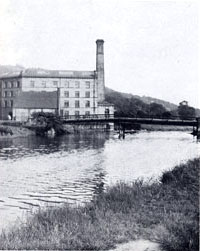In Medieval and Early Modern times, roads and tracks around 'Calderdale' were rough. Travelling by way of them was very difficult. By the late 18th Century, however, new turnpikes were coming into existence. Though not of the standard we expect today, they were a huge improvement on the earlier tracks. This made communication between towns much easier.
Bridges across the local rivers were also critical to travellers, though the safety of bridges in earlier centuries could not always be guaranteed. The Sterne Bridge in Copley was just one example of a structure with a tragic tale attached.
Public rights of way
A key element in the mercantile development of the Calder valley was the distribution of home industry. Also, the essential network of trackways that were built up to connect the various suppliers and traders both in and out of the valley.
Much of this network still remains in the dense concentration of public rights of way in the Borough. With around 850 miles of pathway, Calderdale has more (excluding access land) than any other borough in the UK. Some are no more than paths between farmhouses, while others are more substantial 'causey tracks'. So named, because of the flat stone flags or causeys with which they were paved. Still others are even more substantial, making their way through the hills in 'holloways', or 'dark lanes', as they are frequently known locally.
One of the most impressive of these early paths is a zigzag of wide cobbled tracks. It climbs up Beacon Hill from below Halifax Minster (formerly known as Halifax Parish Church). See: From Weaver to Web: Halifax from the Beacon Hill.
Beside it at one time, was a holy well, another factor indicating the age and importance of the route. On the other side of Beacon Hill, it descends the Southowram hillside as Dark Lane. This name derives from the shade provided by the high banks on either side, in some places 12ft high.
There are also several instances of 'London roads' around the valley, indicating how Calderdale's trackways linked into a known trade network that covered the country from capital to province.
Wherever they ran, because of the cottage industry nature of the valley's economy, these paths should be seen as workers' routes, the precursors of commuter networks. The tracks were walked or traversed by packhorses (generally the small, but sturdy pony known as the Galloway) in caravan.
The furrows worn on the causey stones show how well they were used, before the motor car. The hills would have swarmed with people going about their business on the arterial routes of the clothing trade.
Recommended reading
Packmen, Carriers & Packhorse Ways by David Hey.
Sterne Bridge
A sombre tale

Sterne Bridge in Copley has acquired a certain literary air. Its name comes from the local Sterne family, who lived at nearby Wood Hall. Among their members was Laurence Sterne (1713-1768), author of Tristram Shandy.
Until the present bridge was erected in 1914, a rather slender wooden bridge crossed River Calder at this point. This acquired a certain reputation following a tragedy in the 19th century.
The story varies as to whether a young girl making her way down from Norland Moor on a December evening in the 1800s was on her way to meet her father or mother. Both versions agree that a snow-storm caught her on her way. When the storm had abated, people went searching for the little girl. Her footsteps could be followed only as far as the middle of the bridge. Again, the story diverges here, some say she was never found. Others say she was later found drowned. Local legend believed she still walked the bridge at midnight on the fateful day. However, vigils mounted by local residents have failed to confirm this.
William Wordsworth, hearing of the tragedy, wrote the poem, 'Lucy Gray':
Yet some maintain that to this day
she is a living child,
that you may see sweet Lucy Gray
upon the lonesome wild.
O'er rough and smooth she trips along,
and never looks behind;
and sings a solitary song
that whistles in the wind.
One might wonder, what came first the ghostly legend or the sentimental poem?